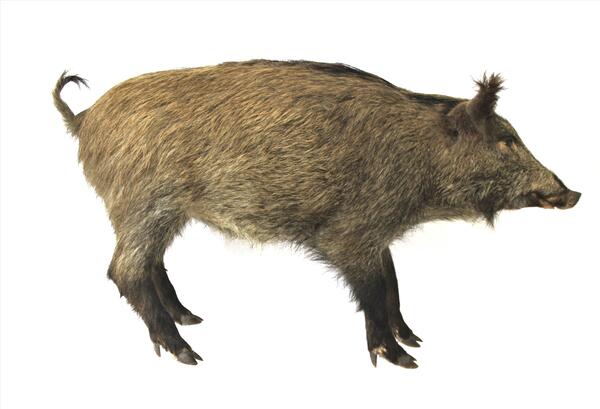Wild boars (or wild pigs) are widely distributed in the Samara Region. They have a large wedge-shaped head stretched forward. Their ears reach out long and wide, their eyes are small, their snouts have a patch. Their body is covered with an elastic bristle, which is longer and denser in winter, and the underfur. On the back of the animal, the bristle is formed into a crest which rises when the animal is excited. The bristle may be light russet or grey, as well as go almost completely black.
Wild boars are cautious still not timid. When annoyed, injured or protecting young animals, they can be extremely dangerous due of their strength and large sharp fangs. Wild boars' preferred habitat is water-rich swampy areas, both covered with woods overgrown with reeds and bushes The preferred habitat of the wild boar is water-rich swampy areas, both wooded and overgrown with reeds and bushes. Old males lead solitary lives and only join sounders to mate. Small matriarchal herds comprise 10–30 females, piglets and young immature males.
Between November and January, barrows fight over sows. Pregnancy lasts for about 18 weeks. The average number of piglets is 4–6, at times growing to 12. In their early days, they have black and russet and yellow stripes as a camouflage out in the forest. Sows furiously yet carefully protect their piglets from danger. Reaching sexual maturity at 1.5, piglets grow up at 5–6.
Wild boars are clumsy, but fast. Excellent swimmers, they are capable to cover considerable distances in the water. Their vision is poorly developed, while their sense of smell and hearing are very effective. At daytime, wild boars lie in a burrowed wallow or, at times, in groups in a den. At the evening time, they come out to bathe and seek food. Wild boars mostly feed on plants: roots, fruits and acorns. They ration may also include smaller animals and carrion. Besides, wild boars may damage the crop feeding on potato, turnip and cereals.
Wild boars are cautious still not timid. When annoyed, injured or protecting young animals, they can be extremely dangerous due of their strength and large sharp fangs. Wild boars' preferred habitat is water-rich swampy areas, both covered with woods overgrown with reeds and bushes The preferred habitat of the wild boar is water-rich swampy areas, both wooded and overgrown with reeds and bushes. Old males lead solitary lives and only join sounders to mate. Small matriarchal herds comprise 10–30 females, piglets and young immature males.
Between November and January, barrows fight over sows. Pregnancy lasts for about 18 weeks. The average number of piglets is 4–6, at times growing to 12. In their early days, they have black and russet and yellow stripes as a camouflage out in the forest. Sows furiously yet carefully protect their piglets from danger. Reaching sexual maturity at 1.5, piglets grow up at 5–6.
Wild boars are clumsy, but fast. Excellent swimmers, they are capable to cover considerable distances in the water. Their vision is poorly developed, while their sense of smell and hearing are very effective. At daytime, wild boars lie in a burrowed wallow or, at times, in groups in a den. At the evening time, they come out to bathe and seek food. Wild boars mostly feed on plants: roots, fruits and acorns. They ration may also include smaller animals and carrion. Besides, wild boars may damage the crop feeding on potato, turnip and cereals.



